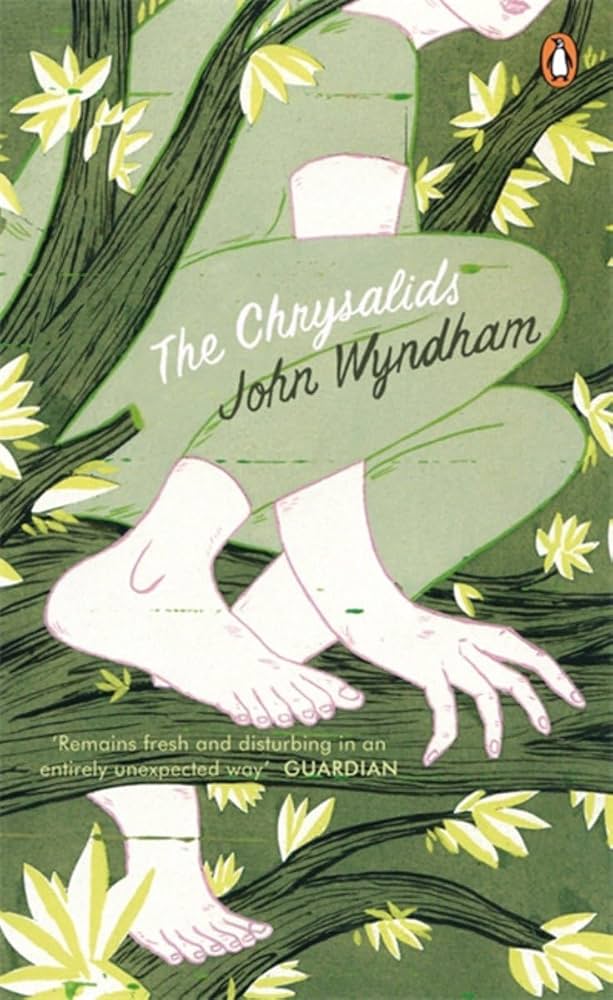
The Chrysalids
Chapter 1
by Wyndham, JohnThe chapter opens with the narrator recalling vivid childhood dreams of a mysterious city by a bay, filled with unfamiliar sights like horseless carts and flying objects. Though young and never having seen a city, the narrator could visualize its streets, buildings, and lights in striking detail. When they asked their sister Mary about it, she dismissed it as a remnant of the “Old People’s” world before a catastrophic event called Tribulation. She warned the narrator to keep these visions secret, as their community frowned upon anything unusual, including the narrator’s left-handedness. Over time, the dreams faded, but the habit of caution remained.
The narrator describes their early life as outwardly normal, though they shared a secret understanding with their cousin Rosalind. This unspoken connection, along with the recurring dreams, hinted at a deeper uniqueness they didn’t yet recognize. At nearly ten years old, the narrator often played alone, exploring the countryside, including a massive bank they assumed was a natural feature. One day, while sliding down a sandy gully, they encountered a stranger—a girl named Sophie, who lived beyond the bank. Her appearance was surprising, as the narrator knew all local children from community gatherings.
Sophie, curious but cautious, joined the narrator in sliding down the sandy slope. Initially reserved, she quickly embraced the fun, her excitement evident. However, on her third attempt, she landed awkwardly and cried out in pain. The narrator rushed to her side, finding her in distress with tears in her eyes. The chapter ends abruptly at this moment, leaving the nature of her injury—and its potential significance—unresolved, hinting at a turning point in the narrator’s life.
The chapter subtly introduces themes of secrecy, difference, and the remnants of a lost world. The narrator’s dreams and their encounter with Sophie suggest a deeper mystery about their society and its rigid norms. The narrative builds tension around the idea of hidden truths, both in the narrator’s visions and in the unexpected connection with Sophie, setting the stage for future revelations about their world and their place in it.
FAQs
1. What does the narrator’s recurring dream of the city reveal about the world he lives in?
Answer:
The narrator’s dream of a futuristic city with horseless carts and flying machines suggests that his current world is a post-apocalyptic society that has regressed technologically. His sister Mary implies this by mentioning “the Old People” and “Tribulation,” indicating a catastrophic event destroyed an advanced civilization. The dream hints at ancestral or genetic memory, as the narrator envisions this city before even knowing what a city is. This contrasts sharply with his rural, seemingly low-tech reality, where such technology is unheard of and even left-handedness is viewed with suspicion.2. Why does Mary warn the narrator not to mention his dreams to others?
Answer:
Mary’s warning reflects the oppressive, conformist nature of their society, which harshly judges anything “odd or unusual.” The narrator notes that even his left-handedness drew disapproval, suggesting strict social norms. By cautioning him to keep the dreams secret, Mary protects him from potential persecution or ostracization. This advice later proves crucial when he hides his psychic connection with Rosalind. The chapter establishes that deviation from the norm is dangerous in this world, foreshadowing larger conflicts about difference and conformity.3. How does the encounter with Sophie mark a turning point for the narrator?
Answer:
Meeting Sophie introduces the narrator to someone outside his known world—both literally (she lives beyond the “foreign” territory of the bank) and figuratively. Her appearance sparks his “first small doubts” about the normality of his life, though he only recognizes this in hindsight. The scene’s tension (her hesitation, his surprise at a stranger) hints at deeper societal divisions. Their playful interaction contrasts with the rigid norms mentioned earlier, suggesting Sophie may represent a challenge to his worldview. The abrupt ending (“It hurts”) implies she may have a physical difference that will become significant.4. Analyze the symbolic significance of the bank in the chapter.
Answer:
The bank serves as both a physical and metaphorical boundary. Initially, the narrator accepts it as a natural part of the landscape, just as he unquestioningly accepts societal norms. Its sheer size (“too big for men to have built”) subtly hints at the lost technology of the Old People. The bank separates his familiar world from the “foreign” territory where Sophie lives, foreshadowing future revelations about societal segregation. The sandy gully where they play becomes a liminal space where boundaries blur—much like their encounter challenges the narrator’s assumptions about his world.5. What themes are introduced through the contrast between the narrator’s dreams and his waking life?
Answer:
The chapter establishes themes of memory, repression, and societal control. The dreams represent a suppressed truth about the past (and possibly the narrator’s latent abilities), while his waking life enforces conformity. The sister’s dismissal of the city as “the world as it had been” introduces a theme of historical erasure after trauma (“Tribulation”). The tension between curiosity and caution—seen in both the dreams and Sophie’s encounter—foreshadows a conflict between seeking truth and maintaining safety in a punitive society. The theme of difference is also introduced, as both the dreams and Sophie deviate from the norm.
Quotes
1 – The compelling insights in this chapter merit deep reflection.
